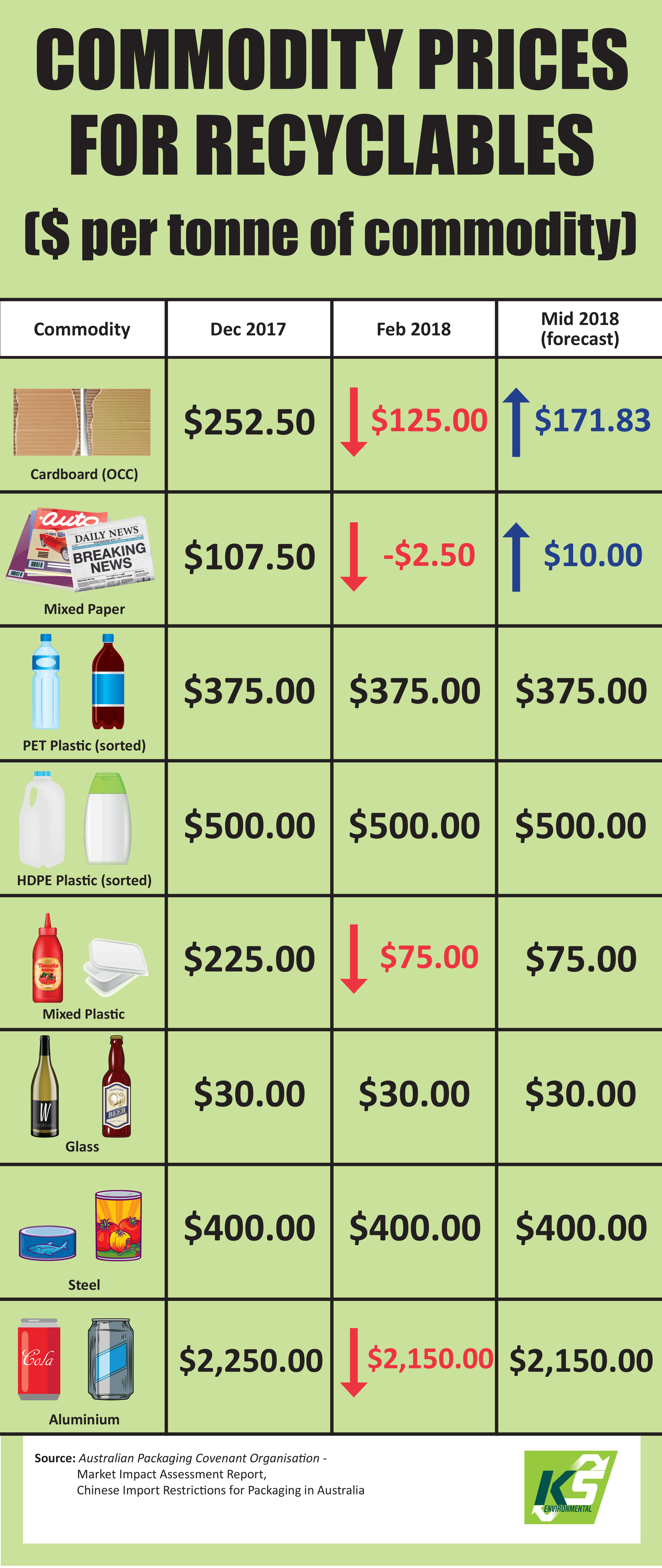We’ve all been hearing about the China ban on recyclables and the current crisis recycling is facing in Australia, but to give some context let’s look at how much commodity prices have actually dropped since the end of 2017 (and forecasts going forward). The below is information obtained from the ‘Australian Packaging Covenant Organisation’ (APCO) recent ‘Market Impact Assessment Report’.
The waste streams most impacted have been scrap paper and plastics which make up a great deal of our packaging. Since the import restrictions, export volumes of scrap paper and plastics have fallen and the destination has changed – we are now sending large amounts to Indonesia, Thailand, Malaysia, India, Republic of Korea and Taiwan. But if quantities remain constant and other countries are also now redirecting recyclables to these locations, it poses the question of how long that will be viable for.
 Cardboard (Old Corrugated Cardboard – OCC)
Cardboard (Old Corrugated Cardboard – OCC)
This is primarily old corrugated cardboard used by industry (this is of a higher spec than mixed paper). It is anticipated that the OCC price will start to recover, however will still sit around 10% lower than the average price has been between July 2015 and June 2017. The recovery will be underpinned by increasing prices for virgin pulp and finished product.
Mixed Paper
This includes items in our kerbside collections like magazines, newspapers, journals, other cardboard and boxboard. While separately these types of items may have strong prices in the market, as they are mixed the value is much lower.
It is expected that the price for mixed paper will also recover, albeit weakly. And will still sit much lower than it was in 2017. Once again, the basis for recovery will be underpinned by prices for virgin pulp and finished product.
Plastics
PET and HDPE prices have been stable and are expected to stay so (however this did follow a big drop off after the mid 2015 – 2017 average price of $225 / tonne).
It has been mixed plastics packaging that was hit by the China import restrictions and as such we saw prices for this waste stream fall dramatically. Unfortunately, the prices for mixed plastics is not expected to recover anytime soon.
Glass
Glass prices have remained unchanged as it is not internationally traded for recycling. Most glass collected in our kerbside collections goes to a beneficiation plant and then to cullet feed at Owens Illinois’ (O-I) glass plants. Some quantities go into lower grade construction applications and some is being stockpiled. The stockpiling is what we originally heard about on the Four Corners investigation last year and could be worrying.
Steel and Aluminium
Prices for both steel and aluminium have not been affected as these commodities are generally traded to local outlets or they make up a very small portion of China exports (which are not subject to the import restrictions).
For a more in-depth look at the packaging effects, click here to view the APCO ‘Market Impact Assessment Report’. This report also outlines what the APCO plans to do going forward to help with the development of more sustainable packaging and initiatives.
Where to from here?
It is worth noting that while steel, aluminium and glass are not affected by the China import restrictions, they could indirectly be impacted as they are all a part of mixed recycling (commingled) collections. It could be a ‘watch this space’ situation.
In regards to solutions, the answer is that right now nobody really knows the exact direction or way out of the crisis, so we can only surmise. The below are some options that are being thrown around in the industry:
- In Victoria, a ‘stop gap’ measure has been implemented by the government in the way of a $13 million package which will assist local recyclers and Councils to cover increased costs.
- Clean up recyclables so China will accept them. Currently the contamination rate in Australia averages at around 6 to 10 percent. China will only accept a 0.5 percent rate. To clean up our recycling to this extent, it would no doubt require new machinery and processes which would be costly and time consuming.
- Waste to Energy Plants (burning waste and using it for energy) – these types of facilities are widespread in Europe, the USA and Asia. In Australia it is a topic that has been discussed widely, with proposals pending in various areas. We do have one going ahead with the first ‘Waste to Energy’ facility in Australia currently under development in Western Australia. The challenge with ‘Waste to Energy’ is not only the cost but also community support and pollution control.
- Recycled glass to be used as a road base (to help with the stock piling issue).
- Landfill – obviously the least desirable outcome! After there has been such an emphasis and effort put into recycling over the years it would be such a shame if this is what it had to come to.
What can we do now?
By far our best form of attack in this situation is defence – by this we mean the avoidance and reduction of recyclables as much as we can to begin with. Click here for some tips on how you can reduce your recyclables at home or at work.
In light of the recycling crisis if you would like to review your waste solutions please contact us.
If you are a current customer and have any questions regarding our collections and destinations please do not hesitate to speak to your current representative or get in touch here.
